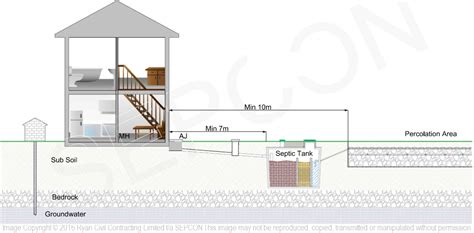How Far From House Is Septic Tank
Ronan Farrow
Apr 04, 2025 · 3 min read

Table of Contents
How Far From the House Should a Septic Tank Be?
Choosing the right location for your septic tank is crucial for its effective functioning and to prevent environmental contamination. The distance from your house is a key factor to consider. While there's no one-size-fits-all answer, this guide will break down the essential considerations to help you determine the optimal placement for your septic tank.
Factors Influencing Septic Tank Placement
Several factors influence the ideal distance between your house and septic tank:
1. Local Building Codes and Regulations
This is the most important factor. Your local government or county health department will have specific regulations regarding minimum setback distances. These codes vary depending on your location, soil type, and other environmental considerations. Before you even think about digging, contact your local authority to obtain the relevant regulations for your area. Ignoring these regulations can lead to hefty fines and the need to relocate your entire system.
2. Soil Type and Drainage
The type of soil significantly impacts how effectively your septic system drains. Well-drained, sandy soil allows for better percolation, potentially allowing for a closer placement. Clay soils, on the other hand, drain poorly and may require a greater distance to ensure proper drainage and prevent backups. A percolation test (performed by a professional) is essential to determine your soil's suitability and inform the placement decision.
3. Proximity to Water Sources
Your septic tank needs to be far enough away from any water sources, such as wells, springs, and surface waters (rivers, lakes, streams). Contamination of these sources can have severe consequences. Again, local regulations will dictate the precise minimum distances. The further away, the better, especially for vulnerable water sources.
4. Accessibility for Maintenance
Consider the accessibility of your septic tank for future maintenance and repairs. Ensure that the tank is easily accessible for pumping and inspection, preferably with a clear, easily-accessible access route. A poorly placed tank can make maintenance difficult and expensive.
5. Property Lines and Other Structures
The placement must also consider property lines and any existing structures on your property. Ensure the tank is entirely within your property boundaries and doesn't interfere with any future construction plans.
General Guidelines (Always Check Local Codes!)
While local regulations supersede any general guidelines, common minimum distances often include:
- 10 feet from the house foundation.
- 50 feet from wells and other drinking water sources.
- 100 feet from surface waters.
Professional Consultation is Key
Determining the precise distance for your septic tank is a complex process. It's highly recommended to consult with a qualified septic system installer or engineer. They will assess your specific property, soil conditions, and local regulations to determine the most suitable location, ensuring a safe, effective, and long-lasting septic system. Investing in professional expertise upfront will save you potential headaches and costs down the line.
This information is for general guidance only and does not replace professional advice. Always consult with local authorities and qualified professionals before undertaking any septic system installation or relocation.
Featured Posts
Also read the following articles
| Article Title | Date |
|---|---|
| How Do Amazon Tribes Deal With Mosquitoes | Apr 04, 2025 |
| How Do I Contact Hauser | Apr 04, 2025 |
| How Did Aaron Brown Pass Away | Apr 04, 2025 |
| How Do Deer Feeders Work | Apr 04, 2025 |
| How Do You Play Mr Fox | Apr 04, 2025 |
Latest Posts
-
How Is Praying In Jesus Name Sometimes Misinterpreted
Apr 04, 2025
-
How Is Cooper Remembered Today
Apr 04, 2025
-
How Is Community Coffee Decaffeinated
Apr 04, 2025
-
How Is Ashley Madison Legal
Apr 04, 2025
-
How Is A Water Bill Calculated
Apr 04, 2025
Thank you for visiting our website which covers about How Far From House Is Septic Tank . We hope the information provided has been useful to you. Feel free to contact us if you have any questions or need further assistance. See you next time and don't miss to bookmark.
